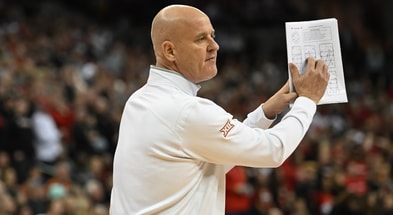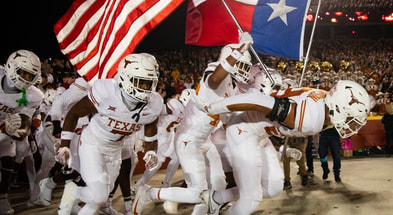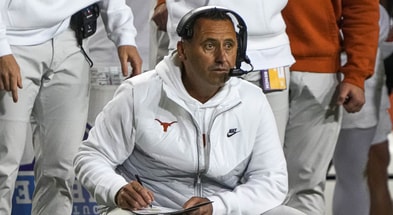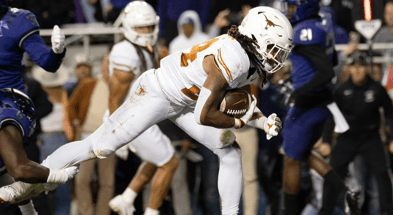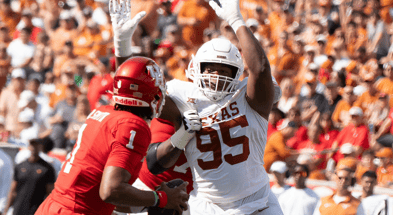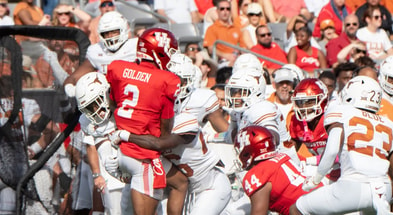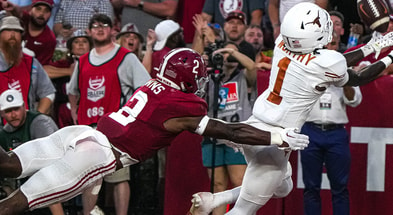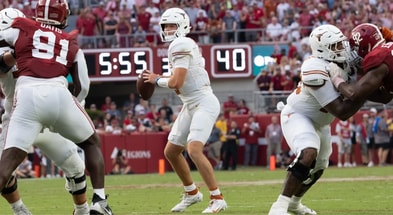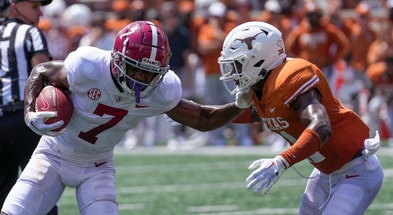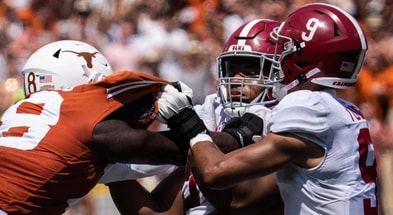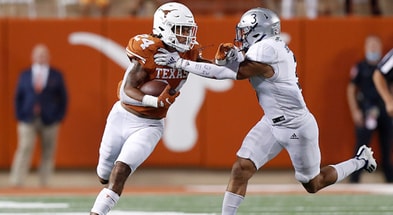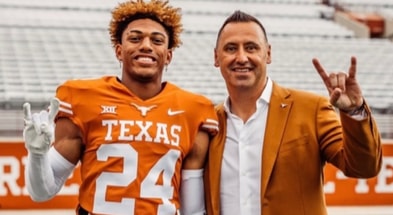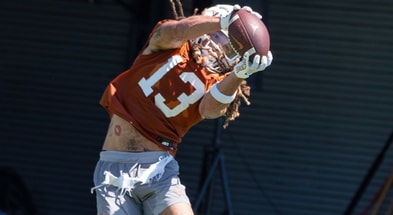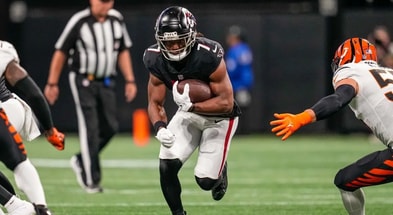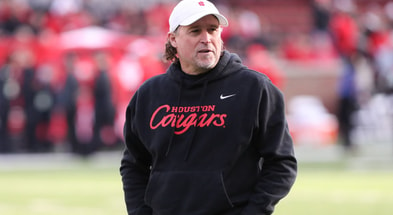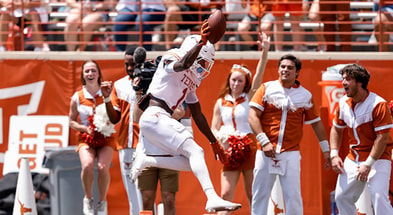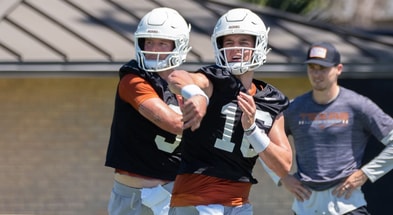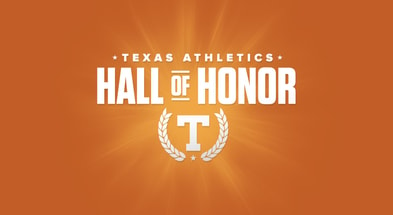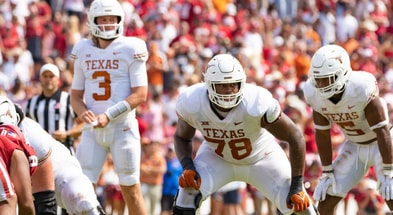Beaten down in the box
Let’s start on defense.
Actually check that. Bijan Robinson had 20 touches in Fayetteville which yielded only 73 yards and one touchdown. The break down is straightforward, he caught one ball for four yards, everything else was in the run game. This was one of the worst run game performances I’ve seen from the Longhorns in a while, reminiscent of the 2019 game in Ames, IA. As it happens, they were facing a similar defensive scheme.
Here’s how the game opened.
It didn’t get any better, really.
Let’s break these two down and then trust me when I say it really is indicative of the issues they had throughout the game.
Example 1. Alright…the fact Bijan moves sides before the snap tells you Texas actually did their homework on the Arkansas flyover defense. The Hogs’ base defense was to play a 5-technique opposite the running back to set the edge. Iowa State does this as well and Todd Orlando finally figured it out in 2020 (too late). The other end/tackle plays in a 3-technique. When Bijan flips sides he has a chance to run at an open edge, and does!
Linebacker Hayden Henry does a good job to turn the ball back in, then Grant Morgan is flying in and Henry is working off Derek Kerstetter’s block to make the stop.
Denzel Okafor doesn’t find anything productive to do here, the scheme is kind of strange. I believe it’s a form of inside zone play. At any rate, Arkansas wins playing 5-on-6 because it comes down to Henry vs Kerstetter and they win that battle.
Is this an RPO? I dunno, maybe a glance to Brewer is open there but I bet he’s just looking to block Jalen Catalon rather than running a route. Honestly, the latter is probably the right call. Any routes outside of Brewer are covered up. Down below the receiver is pressed with a safety over the top so there’s nothing doing there either.
Ostensibly Texas is getting what they want, Bijan isolated on an honest box, but it’s ultimately a trap. Arkansas is happy with these angles and while perhaps it should have been a win, Hayden Henry did not prove as easy to exploit as hoped.
Example 2: This one is much worse. It’s a counter run, again targeting an apparently open edge. Texas DOES have a pass option here (RPO alert!) but Arkansas covers it in man. The alley is wide open and Texas has a guard (Junior Angilau) directed to lead block into it.
So what goes wrong? Jake Majors doesn’t block down, he literally blocks in the wrong direction. The nose tackle inside of Angilau runs free, almost beating Junior to his spot before tackling Bijan from behind. The safety blitzing free off the edge might have been an issue, probably not, but it doesn’t matter because of a simple assignment error.
Assignment errors littered this game, both in run blocking and pass protection. Texas ran mostly inside zone/gap schemes and they lost a few battles but also often just whiffed on their assignments. They were drawn into the same trap Matt Campbell’s defense will set, inviting you to try and overpower them in the box. Power hardly factored in, Texas lost their composure before it came to blows.
The Hog version of the flyover defense was even more extreme than the Cyclones’. They played Markell Utsey as the boundary end/tackle (6-foot-4, 295 pounds) and Tre Williams as the field edge (6-foot-5, 260 pounds), with Isaiah Nichols (6-foot-3, 281 pounds) at nose when John Ridgeway (6-foot-6, 320 pounds) wasn’t spelling him. Grant Morgan (5-foot-11, 222 pounds) and Hayden Henry (6-foot-2, 230 pounds) started at linebacker. Those guys were both rated below .8000 by the services, let that be another lesson (in addition to Texas’ own Luke Brockermeyer) that linebacker rankings don’t necessarily mean much.
Then the Hogs played an extra safety wide in Simeon Blair (5-foot-10, 207 pounds), his job was to play as the free safety and travel wide so B.J. Catalon could stay closer to the box. Didn’t super matter though, not against the run at least, Texas wasn’t getting past the five-man front very often.
And there you have it.
So why? How? What’s next?
Philosophically, Steve Sarkisian wants big bag of offensive schemes to draw from when crafting his gameplans. Ideally he’d have a wealth of tools in his toolbox to control games and attack defenses, assuming his players can actually execute it. Right now? They cannot.
How close are they? Unclear.
It’s important to consider the breadth of change which has occurred. For years, Tom Herman’s philosophy was built on being able to run tight zone against any conceivable defensive front and then account for numbers in the box with the passing game or quarterback runs. It was a big deal in 2020 when they shifted to “let’s run wide zone on every defensive front” and it wasn’t until the end of the year (and after inserting Jake Majors) that they really got it right.
Sark and Kyle Flood want to run outside zone against one team, duo and counter against another, pin and pull or sweeps the next week, and sprinkle in multiple varieties of inside zone every week. Notre Dame has a similar approach these days…it takes a while to develop the O-line for it. Especially when the O-line is A) not great and B) hard-wired by years of training to run the same zone play over half the snaps.
So, is the solution to simplify around what they do best? Maybe (probably), but even then how close are they? Against Arkansas they were in the horrible space where between missed assignments or getting beat, it was hard for anything to go right.
The quarterback battle should be settled by who best sets up Bijan Robinson to win games but the answer to that question will be “no one” if Texas blocks in the Big 12 like they did against Arkansas. The “Casey Thompson gives Texas the best chance to make something of nothing” argument is a dead end. You can’t beat good teams that way, Texas needs to actually develop and execute something on offense. Given Hudson Card’s special ability to hit receivers on the move, it’s not even a no-brainer.
Alright, now let’s talk defense.
Texas played decent defense in this game in the first half and up until the big play surrendered after the Longhorn offense finally scored. From there, things unraveled. The issue was the gameplan, which Pete Kwiatkowski is right to be rethinking.
His plan was to play mostly “vision quarters” with some occasional blitzing, the latter of which would ramp up in the red zone. This was successful at forcing Arkansas to kick field goals. Honestly, this would be a decent gameplan against much of the Big 12, especially with some tighter rotations on defense and continued improvements in technique up front.
Anthony Cook and the Texas cornerbacks are pretty good in this scheme, they tackle well on the perimeter. Texas needs more depth at Jack linebacker, but it wasn’t the killer in this contest.
Here’s two consecutive plays on the Hogs’ second drive which show some of the highs and lows of Texas’ defensive play in this game.
Example 1: This is a nasty play design by Arkansas. They send the running back flaring out to the field, who’s responsible for him? The nickel and the Mike linebacker have to wide and adjust to make sure he doesn’t beat them to the edge on a quick toss. With the Mike linebacker cleared out of the box, or at least frozen in place, the offense then runs GT counter opposite him for their 250 pound quarterback.
Here’s the problem for Arkansas. Who’s the Mike linebacker?
The 2-4-5 has muddied the picture. Jacoby Jones is dropping back to play as the Mike linebacker, the 3-technique is looping to handle his duties on the edge, and Luke Brockermeyer is blitzing into the B-gap to replace the 3-technique. The Hogs don’t pick it up, Brock runs free into space left open by pulling blockers, and K.J. Jefferson is tackled for a loss.
For Texas, this is basically a standard 4-2-5 Over backed by two-high quarters, but by changing just a few roles they maintain a sound, base scheme while creating a big problem for Arkansas.
Example 2: This time there’s no chicanery by Texas, they play it straight in the same defensive scheme. Arkansas uses something they worked throughout the game, getting two eligible receivers into the boundary and having them run a two-man route pattern on a running play (RPO).
It’s the same stress they were trying to create in example one. Does DeMarvion Overshown honor his pass game responsibility against the flat-slant combination by the tight end and outside receiver? Or aggressively fill the open A-gap?
The right answer is A), count his ducks against the pass first by maintaining enough depth and width to rob the slant while leaving the flat route for the cornerback. This might have worked had the nose not been washed down, resulting in a wide open crease for the back to hit without hesitation.
PK’s 2-4-5 hinges on having good, heavy play by the defensive tackles to slow things up inside and afford the rest of the defense time and the defensive coordinator a chance to field some speed and versatility elsewhere.
Here’s the issue for PK, why are you in two-high against K.J. Jefferson and Arkansas. Against Oklahoma who has a more limited arsenal of RPOs and (perhaps) a less physical run game? By all means, make them earn their way down the field and punch the ball in. But against Arkansas, who wants nothing to do with asking Jefferson to beat your coverage down the field, you want to reach for your other base coverage, Match 3.
In Match 3, B.J. Foster drops down in example two to take the tight end and Overshown is free to fill the A-gap without restraint. It seems PK’s thought in this game was “I bet if I make Jefferson and the Hogs earn all their points against two-high, they’ll fail to finish drives.”
A reasonable bet, but you’d have preferred something more aggressive about attacking Jefferson’s weaknesses. The other question everyone is surely asking would be, “was the Texas defensive staff lulled into believing their defensive tackles were better than they are by beating up on the Texas O-line?” With better play at defensive tackle, this gameplan looks better, although they were ultimately doomed by the play of the offense. It would have been very easy for Texas to have played better on defense and still lost.
Before we wrap up on defense, let’s look at the big defensive breakdown which arguably broke PK’s unit in this game.
Unless PK already had it in his arsenal, I think Terry Joseph may have brought this one from Notre Dame. The Irish had a blitz like this which totally befuddled Sam Howell last year. It’s clever, the nickel blitzes the edge and the strong safety comes from the boundary and replaces him in carrying the slot receiver up to the safety. When a quarterback sees a nickel blitzing it’s normal for him to try and find his slot receiver, and then Foster is robbing him.
The problem, aside from the lack fo pressure, is D’Shawn Jamison loses track of his man and lets him run by for an easy pitch and catch. Naturally this mistake came immediately after Texas had finally made some plays by picking off Jefferson (on another of their replacement blitzes) and scoring.
To my eyes the rewatch revealed a defense which is close to being able to execute a high level scheme which is likely to cause tremendous problems for Big 12 offenses. The offense is less close (although how far is unclear) from having enough mastery over their own system to allow Bijan to present similar issues for Big 12 defenses. Rice comes at a nice time, Texas needs an offensive tuneup.
